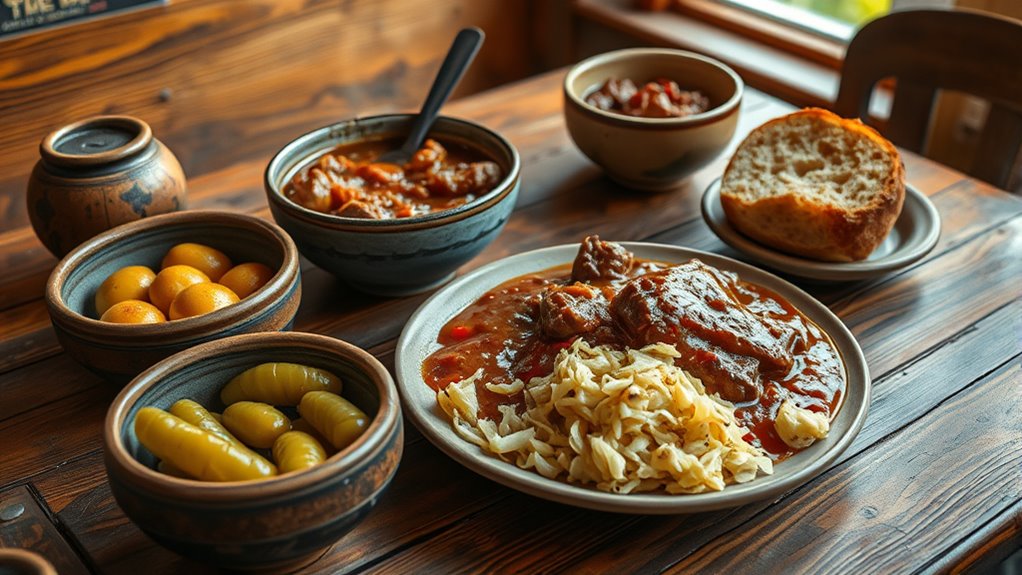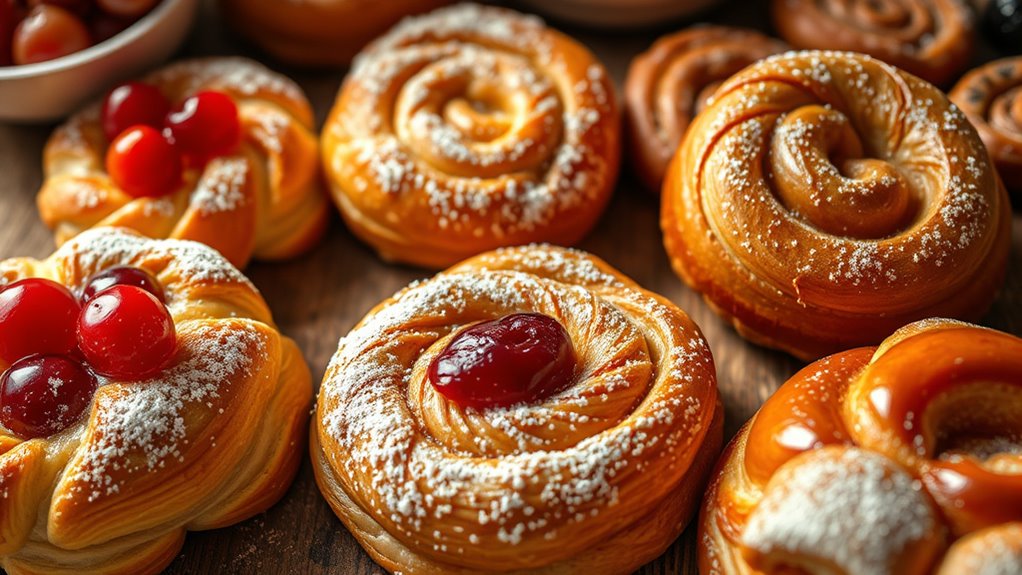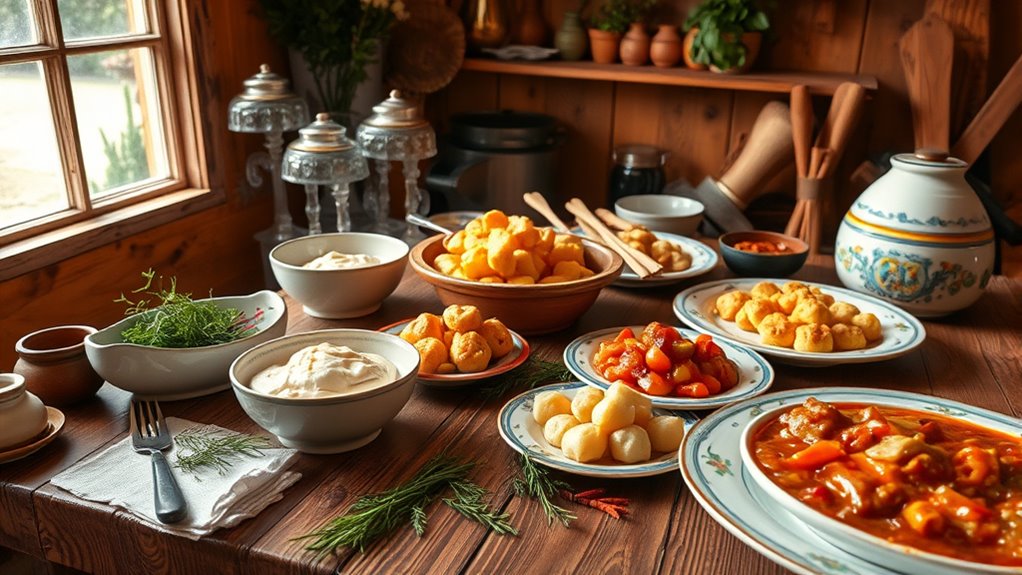Czech cuisine is rooted in central European traditions, emphasizing hearty dishes with pork, potatoes, and cabbage. You’ll find signature meals like roasted meats with dumplings, flavorful soups, and delicious pastries such as koláče. Their culinary heritage combines ancient preservation methods, like fermenting and drying, with influences from neighboring cultures, especially France. If you explore further, you’ll discover how these ingredients and techniques create a comforting, flavorful dining experience rich in history.
Key Takeaways
- Czech cuisine is rooted in German, Austrian, and Hungarian traditions, with influences from French cuisine after 1918.
- Core ingredients include pork, potatoes, cabbage, and dairy, used in hearty, flavorful dishes like goulash and svíčková.
- Preservation techniques such as drying, fermenting, and pickling are integral, contributing sour flavors like sauerkraut and vinegary dressings.
- Traditional meals often feature multiple courses, including hearty soups, meat dishes with dumplings, and sweet pastries like koláče.
- Czech baking emphasizes simple, flavorful pastries and desserts, such as honey cakes and fruit-filled pastries, reflecting a rich culinary heritage.
Historical Roots and Influences Shaping Czech Cuisine

Czech cuisine has been shaped by a rich tapestry of historical influences, reflecting its central location in Europe. You’ll notice German, Austrian, and Hungarian traditions blending into your dishes, especially in hearty favorites like dumplings and goulash. Many recipes date back to the 18th and 19th centuries, although earlier noble or aristocratic meals from the 15th to 17th centuries remain less documented. You’ll also find ways of preserving food, such as drying fruits and making jams, which helped survive harsh winters. Historically, Czech dishes feature sweet and sour flavors, with vinegar and sauerkraut playing key roles. After gaining independence in 1918, the cuisine absorbed influences from Western allies, particularly France, introducing new techniques and flavors that enriched traditional cooking.
Key Ingredients and Traditional Food Staples

At the heart of Czech cuisine are ingredients that create its hearty and comforting dishes, with pork, potatoes, and cabbage standing out as staples. You’ll find pork used in many dishes, from roasts to sausages, often paired with bread or dumplings to satisfy. Potatoes serve as a versatile side, appearing in dishes like knedlíky and soups. Cabbage, whether fermented as sauerkraut or cooked fresh, adds tang and texture, essential in meals like Vepřo-knedlo-zelo. Carrots, onions, and root vegetables enrich sauces and stews, while dairy products like cream and cheese lend richness to many recipes. Legumes and eggs also play a supporting role, helping to create the hearty, flavor-packed dishes Czech cuisine is known for. Incorporating a variety of nutrient-dense ingredients like seeds and vegetables can further enhance the nutritional profile of traditional Czech meals.
Signature Dishes and Culinary Techniques

Signature dishes and cooking techniques define the rich culinary identity of Czechia, blending centuries-old methods with regional flavors. You’ll notice hearty preparations like Vepřo-knedlo-zelo—roast pork with dumplings and sauerkraut—that highlight slow roasting and braising to develop deep flavors. Svíčková na smetaně, marinated beef served with a creamy vegetable sauce, showcases meticulous vegetable pureeing and reduction techniques. Czech cuisine also emphasizes preserving flavors through drying, fermenting, and pickling, especially with sour ingredients like sauerkraut and vinegar. Thick soups and rich sauces, often enriched with dairy or cream, reflect a mastery of creating hearty textures. Baking pastries such as koláče and hoska reveals skilled dough handling and fermentation, integrating sweet elements into traditional dishes. These techniques give Czech cuisine its distinctive, robust character. Additionally, embracing fermentation not only preserves ingredients but also enhances their complex flavors, demonstrating a deep understanding of culinary preservation methods.
Typical Meal Structure and Serving Customs

Meals in Czechia typically follow a structured pattern, often consisting of multiple courses that highlight the country’s culinary traditions. You usually start with a hearty soup, such as thick potato or vegetable broth, served hot and often flavored with cream or sour ingredients like sauerkraut. After the soup, you move on to a meat-based main dish, frequently accompanied by bread dumplings (knedlíky) and vegetables like cabbage or sauerkraut. It’s common to serve a generous portion of sauce or gravy alongside. Beverages like Pilsner beer are preferred to complement the meal. On special occasions, a sweet dessert or fruit compote might follow. This meal structure emphasizes balance, hearty flavors, and the importance of shared, satisfying dining experiences.
Sweets, Pastries, and the Art of Czech Baking

Czech baking boasts a rich tradition of delicious pastries and desserts that reflect the country’s love for sweet flavors and craftsmanship. You’ll find classic treats like koláče—fruit or cheese-filled pastries—and hoska, sweet braided raisin bread, often enjoyed during festivities. Many desserts rely on natural sweetness from ingredients like cream, fruit jams, or carrots, rather than refined sugar. Pastries are often simple yet flavorful, showcasing skilled baking techniques passed down through generations. You might also indulge in cakes, such as the layered medové dort (honey cake), or sweet pies served with coffee. Sweets are typically served as a third course or during special occasions, emphasizing their importance in Czech culinary traditions. This artful baking highlights the country’s heritage and dedication to delightful, comforting treats, often complemented by traditional culinary techniques that have been preserved over centuries.
Frequently Asked Questions
How Has Czech Cuisine Adapted to Modern Dietary Trends?
You’ll notice Czech cuisine has adapted to modern dietary trends by incorporating healthier ingredients and cooking methods. People are now more mindful of balanced eating, so they include more vegetables, lean meats, and plant-based options. Restaurants and home cooks use less salt, sugar, and processed foods, emphasizing fresh, local produce. Additionally, vegan and gluten-free dishes are increasingly common, reflecting a shift towards more inclusive and health-conscious eating habits.
What Regional Variations Exist Within Czech Culinary Traditions?
You’d find that Czech culinary traditions vary regionally, like apples and oranges. In Bohemia, hearty meat dishes like svíčková dominate, with an emphasis on rich sauces and dumplings. Moravia adds a spicy twist with hotter sausages and wine-infused dishes, while Silesia favors simpler fare like smoked meats and hearty stews. Each region’s flavors reflect local ingredients, climate, and history, giving Czech cuisine a rich, diverse tapestry.
Are There Any Unique Traditional Beverages Besides Beer?
Yes, besides beer, you can enjoy traditional Czech beverages like slivovice, a strong plum brandy, and medovina, honey mead. You might also try borovička, a juniper berry spirit. These drinks hold cultural significance and are often served during celebrations or as a warming sip on cold days. They reflect the country’s rich history of fruit and herbal infusions, offering a unique taste of Czech heritage beyond just beer.
How Do Seasonal Ingredients Influence Czech Cooking Practices?
Seasonal ingredients shape your Czech cooking like a painter’s palette, bringing vibrant flavors throughout the year. In winter, you rely on dried fruits, jams, and preserved vegetables to keep hearty stews warm. Spring and summer invite fresh herbs, peas, and strawberries, infusing dishes with brightness. You adapt recipes to nature’s bounty, ensuring each season’s ingredients add authenticity and richness, turning simple meals into a celebration of the land’s changing rhythms.
What Role Do Festivals Play in Preserving Czech Culinary Heritage?
Festivals play a essential role in preserving Czech culinary heritage by showcasing traditional dishes, pastries, and drinks during special celebrations. You get to experience authentic flavors passed down through generations, often prepared with time-honored techniques. These events also encourage community bonding, allowing you to learn about regional specialties and food customs firsthand. By participating, you help keep Czech culinary traditions alive, ensuring they remain part of the country’s cultural identity.
Conclusion
Did you know that Czech cuisine has over 20 traditional hearty dishes passed down through generations? As you explore its rich history, you’ll find that hearty stews, dumplings, and sweet pastries define the culinary landscape. Embrace the cultural flavors and enjoy every bite, knowing you’re tasting centuries of tradition. Whether you’re savoring a velvety goulash or a flaky strudel, Czech food offers a delightful journey through its vibrant culinary heritage.









